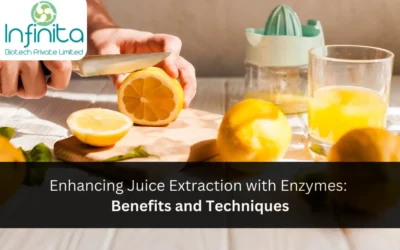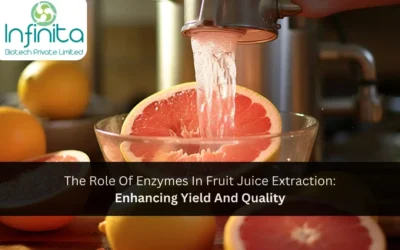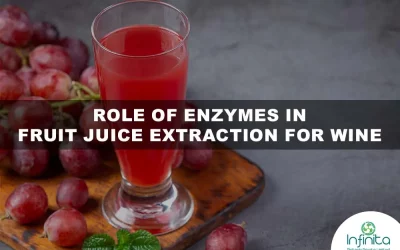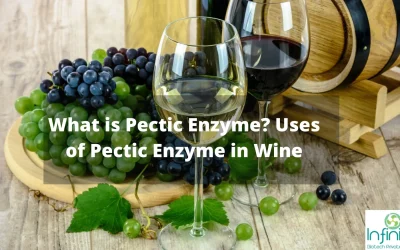What Is Pectin Methylesterase? 3 Uses Of Pectin Methylesterase
Pectinases also known as pectinolytic enzymes are a heterogeneous category of enzymes that react on the pectic substances found in plants. Specifically, pectinases hydrolyse them. Pectinases include polygalacturonase, pectin lyase and pectin methylesterase (PME). They hydrolyse the glycosidic bonds of pectic substances. Plants, pathogenic fungi and bacteria make pectin methylesterase which is a methyl ester group hydrolytic enzyme. It is widely used in the wine, juice and other food industry. The mechanism that pectin methylesterase used to catalyse reaction is called the double-displacement mechanism. This is the de-esterification through the transference of the C6 carboxyl groups in the pectin-PME complexes to water molecules. This leads to the change in the degree and pattern of methyl esterification and transacylation as the C6carboxyl groups are transferred to the hydroxyl groups of other pectin molecules. This results in the production of pectins with a high molecular weight with novel non-methoxy-ester linkages. Pectin methylesterase has been purified and identified in several different fruits which include tomatoes, oranges, papaya, apples, and kiwis. The food industry would find PMEs with well-defined and diverse activities pretty useful for making ‘designer pectins’ to fulfil rising demands in the industry. There is evidence suggesting that the activity of pectin methylesterase is partially regulated by pectin methylesterase inhibitors (PMEI).
Types Of Pectin Methylesterases:
Evidence suggests the existence pf several pectin methylesterases that differ in their molecular weight, pI and biochemical activity in plants and plant pathogenic fungi. Linum usitatissimum has a basic PME which is an isoform of B3a and can be found encoded by LuPME3. It plays an important part in flax root development. PME is a part of class 8 (CE-8) of the carbohydrate esterases group and belongs to varied families. It has different open reading frames (ORF) of full-length PMEs depending on species of plants and the level of pectin in their cell walls. For example, Arabidopsis thaliana has 66 while in Populus trichocarpa there are 89 ORFs.
Mode of action of mature PMEs:
After they are secreted into the cell wall mature pectin methylesterases display three different modes of action. These modes of actions are:
- Single chain mechanism in which the enzyme transforms all substate sites on the polymeric chain.
- Multiple chain mechanism in which the enzyme catalyses one reaction and disassociates from the substrate
- Multiple attack mechanism in which the enzyme catalyses many reaction cycles before the disassociation of the enzyme-polysaccharide complex.
Pectin methylesterases found in bacteria and plants have products with adjacent sites of galacturonic acid and make use of both single-chain and multiple attack mechanisms. On the other hand, pectin methylesterases found in fungi attack randomly and make use of the multiple-chain mechanism. Random action of pectin methylesterases on pectic polymer leads to the demethylesterfication which release protons that promote the action of endopolygalacturonases and loosen the cell wall. The linear action of PMEs on methylated pectin, it leads to the rise of blocks of free carboxyl groups that could link to Ca2+ which would create junction zones. Since the action of endopolygalacturonases in this type of gel is restricted, linear action of PMEs leads to the cell wall stiffening.
Functions Of Pectin Methylesterases:
1. They Are Enzymes That Are Implicated In Many Physiological Processes:
Research has shown that there exists a strong correlation between the activity of pectin methylesterase or gene expression of pectin methylesterase and the physiological processes like fruit maturation, cambial cell differentiation, pollen tube growth, and microsporogenesis.
2. They Act As A Source Of Methanol:
A study conducted in 1998, suggests a close correlation between pectin methylesterase activity and levels of methanol found in fruit tissue particularly that of tomatoes. This indicates that PME is on the primary biosynthetic pathway for the production of methanol in tomatoes.
3. Pectin Methylesterases Help In Cell Adhesion:
Evidence suggests that PME activity increases with an increase in the amount of acidic pectin and a decrease in the pH of the cell wall. The analysis conducted on transgenic plants displayed that rcpme1 expression was needed for the maintenance of extracellular pH, elongation of cells inside the tip of the root and for the degradation of the cell wall which leads to border cell separation.
4. Pectin Methylesterases Aid In The Elongation Of The Stem:
A study conducted on transgenic potato plants showed that the apex of the stem had fewer levels of pectin methylesterase activity than the wild type. It also showed that in the early stages of development, the stems of the transgenic potato plant had stems that were more elongated than those of the wild types.
5. Transacylation Properties of PME:
Aspergillus niger contains pectin methylesterase that catalyses the transacylation reaction to form polymerised pectin. This was proven because there was an increase in the particle size of PME-catalysed pectin solution. Microbial and plants have different transacylation mechanisms as there are at least two kinds of PME- catalysed transacylation.
Industrial Uses Of Pectin Methylesterases:
The commercial use of pectinases in the fruit juice industry dates back to 1930. In fact, pectinases account for 25% of global food enzymes. There are typically produced from fungal sources and are used in the food industry They do not require purification. Pectin methylesterase is used in combination with other enzymes but can also be used in isolation. The processes for which pectin methylesterase is used are discussed below.
1. Clarification Of Juices:
The cloudiness of fruit juices is mainly caused by pectic substances. Therefore, the production of clear fruit juices requires the degradation of pectin in the juices through the use of pectinases. Degrading the pectin in fruit juices also causes a decrease in viscosity of the fruit juice and make the filtration and concentration processes easier. Pectin methylesterase is used in combination with other pectinases to degrade the pectin. As the pectin degrades, the viscosity of the fruit juice decreases and the suspended cloud particles lose their stability and precipitate. The clarification of the fruit juices requires that pectin methylesterase be used alone. However, this treatment requires that CaCl2 be added to the fruit juice so that the pectin that is in the form of insoluble calcium pectates is removed from the fruit juice leading to clarification. Pectinases are also used in the fruit juice industry to liquify fruit mashes. The pectinases are mixed with cellulases and hemicellulases for the total disruption of cell walls.
2. Firming Of Fruits And Vegetables Before Processing:
The texture of fresh and processed fruits and vegetables is strongly linked with the structural integrity of the primary cell walls and middle lamella, which are mainly made of pectic substances. Most processes like dehydration, blanching, freezing pasteurisation and sterilisation to preserve fruits and vegetables lead to irreversible physical damage of the cell wall. Fortunately, with the help of the pectin methylesterase enzyme, these damages can be overcome. For example, to make fruits and vegetables firm, pectin methylesterase and calcium chloride are used through vacuum infusion. This is caused by the demethylation of naturally occurring pectin in plant tissues by pectin methylesterases and chelating the naturally added calcium that has the free carboxyl groups generated in pectin molecules.
3. Production Of Low Sugar Jams And Jellies:
Typically the HM pectin is used to prepare jams and jellies. This is due to the gelling mechanism of HM pectin which is based on the hydrophobic interactions and dehydration at a low pH. These gels require higher concentrations of sugar for gelling to occur. However, LM pectin forms the gels through the ionic associations with calcium or other divalent cations which interact with a free carboxylic acid of two adjacent chains producing to cross-linking of these chains. This gelling mechanism does not take sugar concentration into account. Hence LM pectins can be used to produce low sugar jams and jellies.
This concludes the comprehensive guide on pectin methylesterase and uses of this enzyme in the food industry. However, the list of its uses is not exhaustive and PME can be used for a variety of other applications as well like the peeling of delicate fruits to obtain whole fruit segments. Hence pectin methylesterase is very important to the fruit juice industry.





